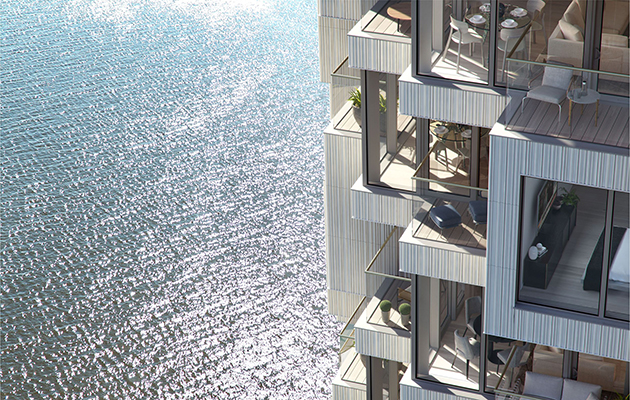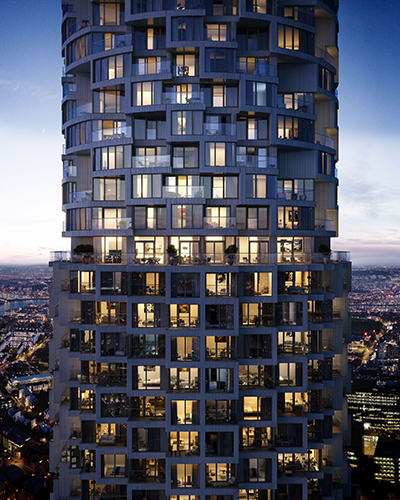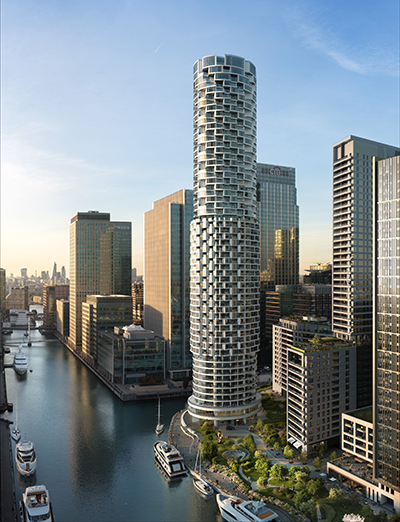|
|
||
|
Tower will be Swiss practice’s first residential project in the UK Ascan Mergenthaler, senior partner at Herzog & de Meuron, flew into City Airport for a single rainy morning for the press launch of One Park Drive last week. This 58-storey, 212m-tall residential tower is the signature project for a new 22-acre mixed-use ‘private district’ that will expand Canary Wharf to 128 acres upon completion in 2023. This is Canary Wharf’s first foray into residential, with a half-half mix of sale and rental across its 3,300 homes, one-quarter of which will be affordable. The new area is master-planned by Allies & Morrison, and the first building, 10 Park Drive by Stanton Williams, launched in 2015. Herzog & de Meuron’s contribution occupies a prime location on the waterfront of the old Wood Wharf, just opposite Canary Wharf. One Park Drive will be the tallest structure on the new estate, which falls away in height as it gets further from One Canada Square. The tower is already one level above grade, and should complete in 2020. Its 483 apartments are sale only, with the ambition of appealing to the readymade market of 120,000 workers at Canary Wharf (or at least the wealthier portion of them), and to those attracted by its improving transport connections. In agreement with the GLA, the launch is being held in London to give UK purchasers the first bite of the cherry and minimise investor acquisitions.
One Park Drive is Herzog & de Meuron’s first residential project in the UK, and was the result of a competition, although Mergenthaler admits to initial qualms around Canary Wharf’s emphasis on the project as ‘product’. The waterfront location and the developers’ emphasis on creating a genuine residential neighbourhood eventually proved persuasive. Experiments were made with various forms, including stacked blocks and polygons, before the firm arrived at a sculptural stack of three cylinders that express evolving internal plans. Mergenthaler says it ‘shares the same DNA but with different results’ with the firm’s recent 56 Leonard in New York and Beirut Terraces in Lebanon, all of which react to their varied locations, client programmes, climates and so on. One rationale for the cylindrical form was to achieve a contrast with the rectangular towers that dominate Canary Wharf’s commercial district, thus marking its residential purpose. The circle is an awkward form for offices, but once a square floorplan is imposed, dual aspects are maximised and leftover spaces can be used for balconies – if storeys are twisted, overhangs are achieved. The floor plan has also been rotated 45 degrees to ensure even light and avoid north-facing aspects. To achieve saleability at lower storeys, levels two to nine (‘The Loft’), which sit above retail and residential facilities, are given tall ceilings and expansive balconies, creating an elegant circular silhouette. These balconies also ensure interaction with the public realm and a relationship with the water below. Above is ‘The Cluster’ on levels 10 to 32 – smaller flats, from studios to two-bed, all with rectangular window bays and balconies (none overlooked due to rotating plans, though some diminutive), giving this portion of the tower a more broken-up appearance. Finally, there is a more rounded group of storeys – levels 33 to 57 –containing larger flats, named ‘The Bay’ after the expansive circular bay windows that give panoramic views across London. At the very top are two storeys of penthouses, their additional floor-to-ceiling heights giving the appearance of extrusion at the top.
The ambition, according to Mergenthaler, is to find a method of achieving intimacy in a tower. In place of curtain glass, recessed, opening windows create a sense of home internally while expressing the floor plans in the facade. The robust skeleton aids thermal gain, and – to further the sense of materiality – is clad in a system of 12 extruded, undulating terracotta tiles. The sheltered balconies, which are often double-height, are integral to the structure, thus encouraging both confidence in their stability and their use. Cost rises since Brexit currently run at about 15 per cent, due both to the fall in the value of the pound and concerns regarding future labour costs, but apartments will still go on sale on 4 May. |
Words John Jervis |
|




















